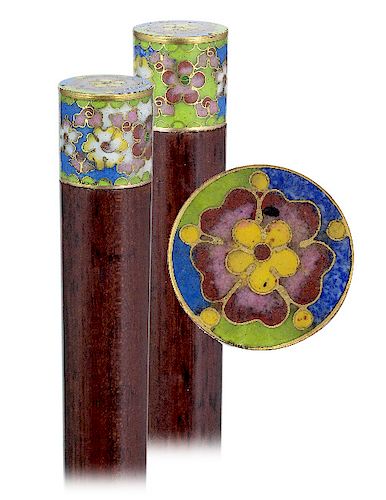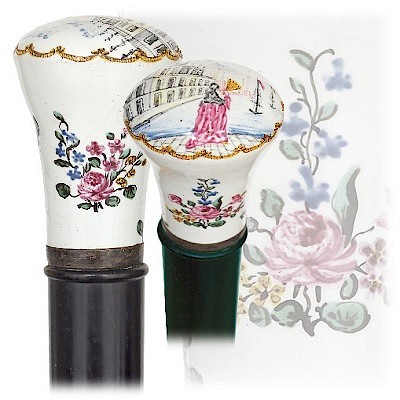163. Cloisonné Enamel Dress Cane -Ca. 1900 -Shippo cloisonné enamel small cylindrical knob with round and flattop totally enameled in well-matched pas
Lot 163
About Seller
Kimball Sterling
125 West Market Street
Johnson City, TN 37604
United States
Family-owned and family-run Johnson City Tennessee auction business for 25 years. Selling antiques and collectables for 38 years. Kimball M. Sterling, Inc. was founded and is owned by Kimball and Victoria Sterling, time and again, they have laid solid claim to world-wide attention and renown with an...Read more
Categories
Estimate:
$300 - $400
Absentee vs Live bid
Two ways to bid:
- Leave a max absentee bid and the platform will bid on your behalf up to your maximum bid during the live auction.
- Bid live during the auction and your bids will be submitted real-time to the auctioneer.
Bid Increments
| Price | Bid Increment |
|---|---|
| $0 | $10 |
| $100 | $25 |
| $500 | $50 |
| $1,000 | $100 |
About Auction
By Kimball Sterling
Dec 8, 2018
Set Reminder
2018-12-08 11:00:00
2018-12-08 11:00:00
America/New_York
Bidsquare
Bidsquare : Antique Canes and Walking Sticks
https://www.bidsquare.com/auctions/kimball-sterling/antique-canes-and-walking-sticks-3643
A collection of 200 canes and walking sticks. Many different categories are presented in this single owner European collection Kimball Sterling kimballsterling@earthlink.net
A collection of 200 canes and walking sticks. Many different categories are presented in this single owner European collection Kimball Sterling kimballsterling@earthlink.net
- Lot Description
163. Cloisonné Enamel Dress Cane -Ca. 1900 -Shippo cloisonné enamel small cylindrical knob with round and flattop totally enameled in well-matched pastel colors with various blooms. The knob is executed in the ancient and traditional Far-Eastern love for the detail perfection, and comes on a snake wood shaft, license for ultimate luxury, and a horn ferrule. This cane exudes class and elegance, and, despite a great fragility, it survived intact and in mint condition. -H. ¾” x ¾”, O.L. 35 ¾” -$300-$400 -Cloisonné is a way of enameling an object, (typically made of copper) whereby fine wires are used to delineate the decorative areas (cloisons in French, hence cloisonné) into which enamel paste is applied before the object is fired and polished. -The Japanese characters used for the word shippo (the Japanese term for enamelware) mean “Seven Treasures” which is a reference to the seven treasures mentioned in Buddhist texts. Although these treasures may vary, they generally included at least some of the following: gold, silver, emerald, coral, agate, lapis lazuli, giant clamshell, glass and pearl. The Japanese applied this expression to the rich colors found on Chinese enamel wares and later to those they made themselves. -Piratinera guianensis or snake wood belongs to the family of Moraceae and originates in tropical South America. It is a truly exotic species and probably one of the most difficult woods to find. Typically, it is a very small tree, and only shows the wonderful reddish brown heartwood with speckles of black appearing as hieroglyphics or snakeskin markings in a small quantity of the wood, and then rarely evenly spread across the entire face of the board. Its markings which resemble those of a snakeskin, give this small, relatively rare timber its name. Snake wood is dense, extremely heavy and hard, brittle and splits easily. It becomes very smooth when finished and has natural polish.
- Shipping Info
-
Each auction has different shipping terms but the buyer always pays.Canes:After payment has been received we will ship in-house the domestic orders, International bidders will be shipped by the UPS store (423-979-7122) and email store4146@theupsstore.com After we receive payment we will deliver to the UPS store and they will contact you.Other Auctions:After payment has been received and cleared we will deliver your items to the UPS Store and they will quote and prepare for shipping.phone (423-979-7122 and email store4146@theupsstore.com
-
- Buyer's Premium



 EUR
EUR CAD
CAD AUD
AUD GBP
GBP MXN
MXN HKD
HKD CNY
CNY MYR
MYR SEK
SEK SGD
SGD CHF
CHF THB
THB
















